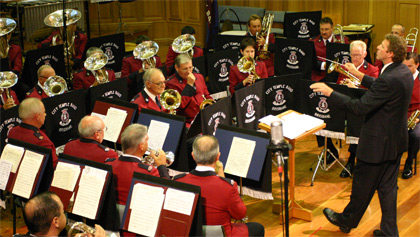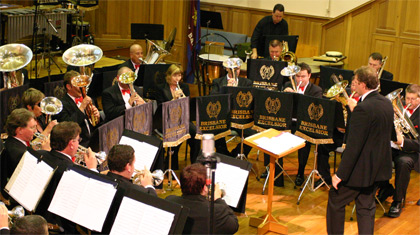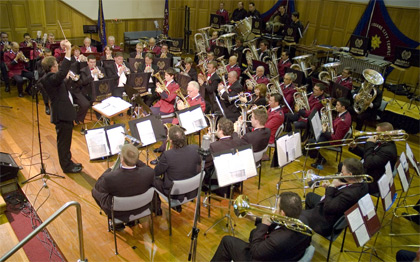Classics to Contemporary: Brisbane City Temple and Brisbane Excelsior Band
30-Nov-2006This concert, at the Brisbane Salvation Army Temple Hall Saturday 25 November, featured a good variety of arrangements and works from throughout the ages, all under the baton of Brisbane Excelsior's current Music Director, Howard Taylor.
Before I get into the main part of this review, there is something that I need to get off my chest, as it affected my experience of the performance, and that of other concert goers.
As a keen concert goer, and not mentioning my capacity here as an occasional concert reviewer, there is nothing more detracting than going to a concert to only have it blemished by having other members of the audience talking too much, and too loud. It isn't socially acceptable to talk during a film in a cinema- unless of course you're at home and you're sitting in front of the television. But it seems to me that it should be less acceptable when the people you are watching aren't pre-recorded. Is that how live concerts are perceived by some members of the audience these days- as a substitute for the mindlessness of television?
The first half featured the Temple Band, in their home location. Starting off the concert was Turkington's march, Able, which gave a lively and punchy beginning to this concert. The Temple Band have a nice round sound in their higher dynamics, but seemed to struggle with their intonation and rhythmic tightness in the softer and more exposed passages, such as those found in, New Frontier, and in the work that followed this, Thine Alone. Although the accompaniment for the horn section feature, Thine alone, was balanced and supportive of the soloists, it was just a little too much for, There Will Be God, in which the euphonium soloist, Todd Everitt, would have been given a better chance to show his finesse if the band had been a little more sympathetic to his designs. Despite their confidence being less assured in these areas, the Temple Band still displayed many fine qualities that aided them in providing an entertaining and enjoyable performance.

Brisbane City Temple Band
A new work by Howard Evans, Chassidic Dance, was a lively inclusion to the program, and hopefully we'll hear more performances of this work in the future. This featured some fine playing from the band, and they displayed good control, and seemed to be responsive to the guidance provided by their guest conductor.
The last two works performed by the Temple Band were both transcriptions/arrangements by Ray Steadman-Allen - Greig's, The Last Spring, and, Themes From The New World Symphony, of Dvorak. I have a question for arrangers: why do we persist in continuing to use the roll on a snare drum as a means of heightening our louder dynamics? I could appreciate that it might be necessary for some arrangements to need this reinforcement in outdoor performances (this isn't one of those pieces), but it completely detracts from the marvelous colours that Steadman-Allen uses in this otherwise controlled and sensitive arrangement. The questions that I have, in a similar vein, about the treatment of the Dvorak arrangement are too various to go into here (particularly about the use of the trombones, instead of the horns for a lot of the original French horn unison passages), and would take up a whole article in their own right. The band made good work of these, with some nice dynamics and shading throughout.
The second half of the concert featured the Brisbane Excelsior Band, who are the current Australian National Champions. They started their program with Praetorius', Four French Renaissance Dances, arranged by Anthum. This is an antiphonal work, and the temple was probably not the best venue to do this work, based upon the size and seating arrangements of the hall. The choirs, which need to be separate from each other, seemed to have their respective members too far apart from each other, and needed to be on the perimeter of the audience, rather than in the middle of them. Despite this, there was some nice tight and polished playing, and the tutti sections, where the divisions between the choirs are less necessary, were particularly exciting.

Brisbane Excelsior Band
Howard Snell's arrangement of Johann Strauss', Czardas, was next on the program, and this entertaining piece displayed the band's control and dynamic shading. Less impressive was the band's performance of Mozart's, The Magic Flute Overture, where I felt that some of the subtleties of Mozart's writing weren't realised. The opening chords, and in particular their restatement later on in the work, are always a tricky spot to be handled. Some of the accents were occasionally harsh and inconsistent, the louder dynamics too loud, and some of the 'spooky' elements in the fugal section not soft or spooky enough for my tastes.
A euphonium section (and Eb bass) feature was next, with an adaptation of Graham's arrangement of, Swedish Hymn. It would have been very easy for this piece to have become heavy and ponderous due to the combined lower sounds of the solo instruments, but there was a good blend amongst the soloists, which was backed up by some sensitive and well balanced accompanying from the band.
Norbury's, Gaudete- a selection of medieval carols- was a great vehicle to display the band's strengths, and all of the band's members were kept on their toes for this energetic and fast-paced piece.
Amanda Casagrande performed the Newton's Flugelhorn solo, "Dimitri", next (I have to be careful what I say here or I might not get invited to do a review ever again!). Amanda's relaxed warm sound was backed up by some lovely sympathetic and transparent accompanying by the band - an enjoyable piece throughout.
Malcolm Arnold, who only passed away this year, was featured with a performance of his, Peterloo Overture. The band gave a good account of itself with this piece, with some lovely warm and round sounds at the beginning. My only criticism of the fast-paced middle section would be that some of the note values tended to become clipped, and the return of the slower section at the end had some not so confident moments in the backrow cornets. However, this was more than made up for the lovely treatment of the cascading figures, between the cornets and horns, at the end of the work. The fact that the occasional lapses of concentration, and those in the pieces mentioned above, can actually be attributed to particular areas of the ensemble is a tribute to the assurance of the respective sections of the band, and to the transparency that is achieved by their conductor.

Massed Bands
Photo: Dean Harring (Hardware Creative)
Naturally allergic to massed band performances (so many that I've been involved with that become a competition to see if you can play louder than your counterpart in the other band - and which I took the bait of when I was much younger…and noisier!), it came as a pleasant surprise to me to see that the control that we had enjoyed throughout tonight's concert hadn't been left to the wayside as the band's combined to perform Gregson's, Dalaro, and Himes' arrangement of Wagner's, Elsa's Procession to the Cathedral. The clarity of the sparsely orchestrated beginning of the Wagner was carried right to the very end of the work, where the whole ensemble is in full voice. This was an impressive and rousing end to a well chosen and entertaining concert.
Adrian Head



